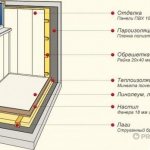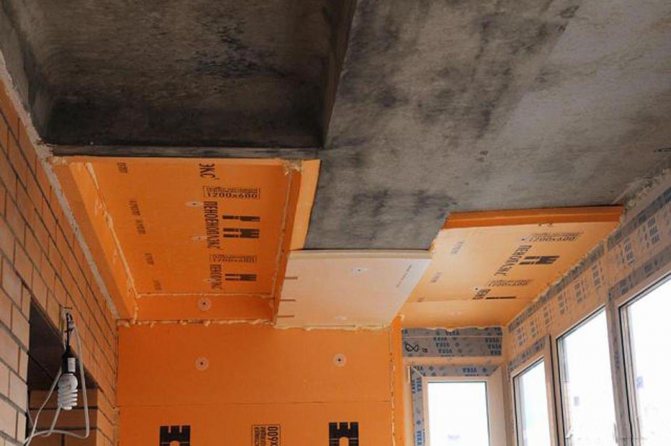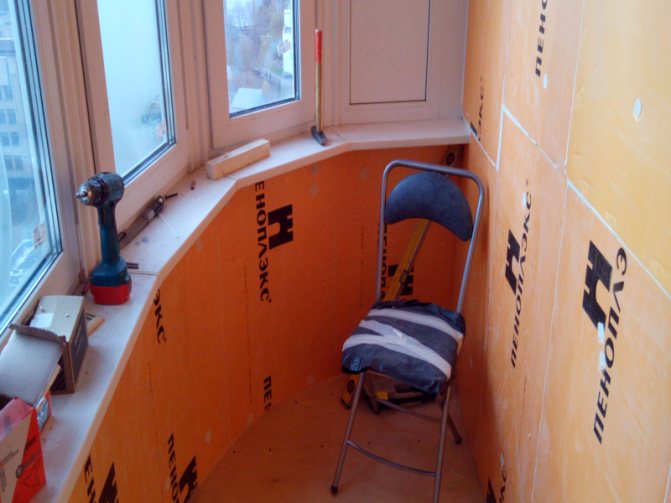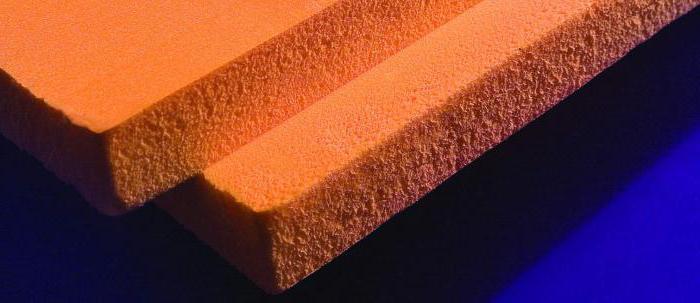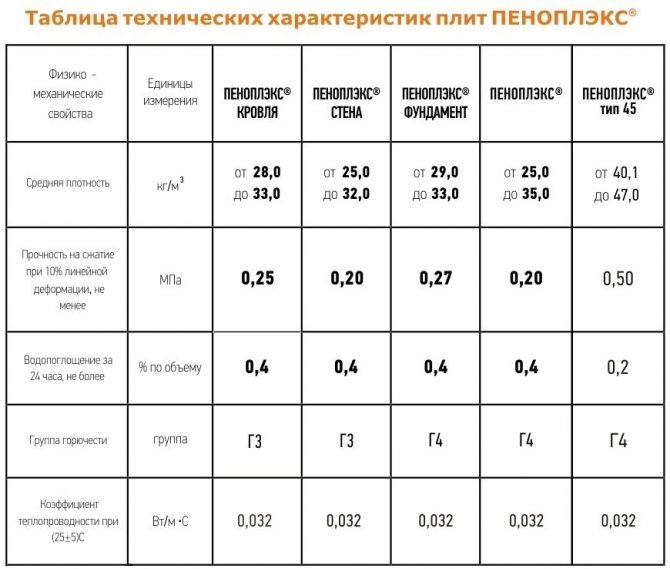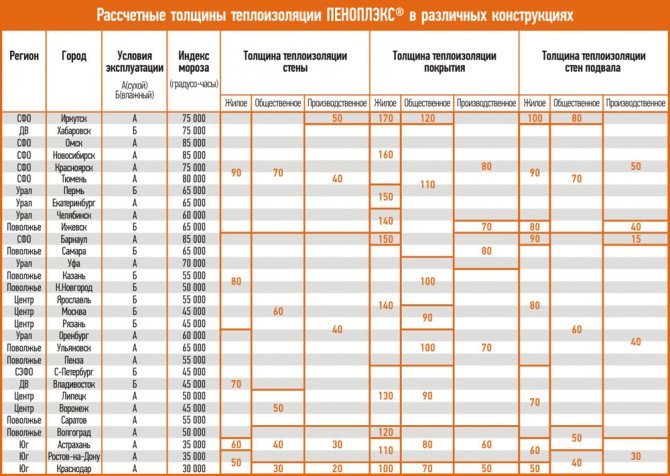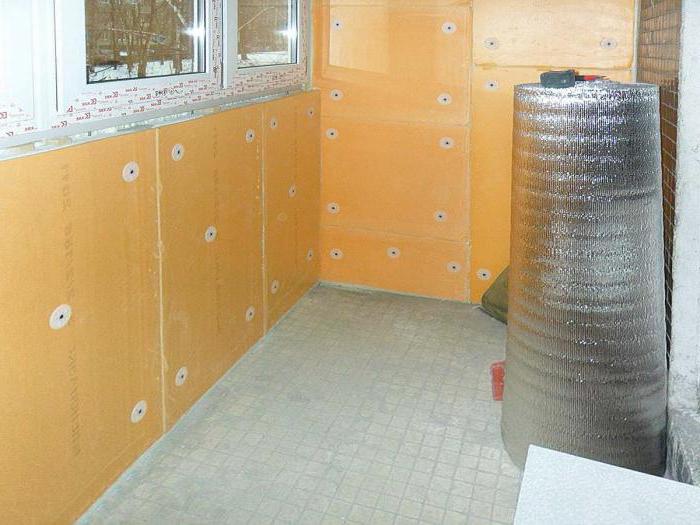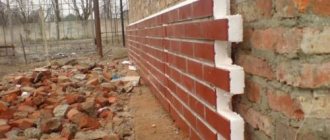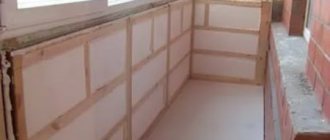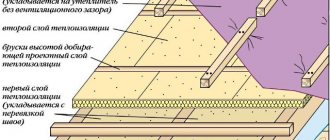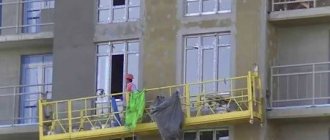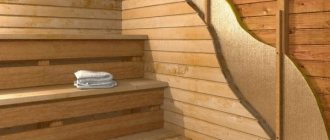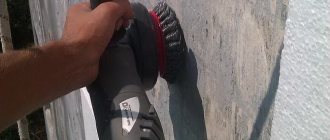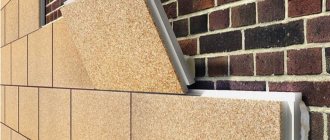By insulating a glazed balcony or loggia, you can get additional usable area and use it with great benefit. In order for the insulation to be effective, it is necessary to choose a high-quality and good insulation. Penoplex building material is very popular, which today is the best insulation. With the help of penoplex, it is quite easy to carry out the work on insulating a loggia or balcony with your own hands. Those who have not yet worked with this material must first familiarize themselves with its characteristics, study the features of the use of penoplex and watch the training video.
- 2 General rules when working with penoplex
- 3 Preparing a loggia or balcony for insulation
- 4 Do-it-yourself ceiling insulation
- 5 Do-it-yourself floor insulation with penoplex
- 6 Insulation of the balcony walls with penoplex
6.1 Surface finishing after balcony insulation
- 6.2 A few useful tips for foam insulation
The main characteristics of penoplex
Penoplex is a foamed extrusion material that is gas-filled. It is made of expanded polystyrene by extrusion and possesses moisture resistance, thermal conductivity and great strength.
Due to its characteristics, the material can withstand maximum loads, therefore it is suitable for floor insulation. Penoplex is thinner than polystyrene, which allows it to save indoor space when used. Despite the high cost of insulation, due to its properties, it is widely used for insulation of various kinds of premises.
Penoplex advantages:
- Insulation is stronger than mineral wool and foam. It can withstand high compressive loads and is resistant to deformation.
- Penoplex is a very light material, which is important for its use when insulating balconies.
- Insulation, consisting of dense balls with air, therefore does not absorb water at all. Thanks to this property, it can last for at least fifty years.
- Penoplex, which contains flame retardants, is non-flammable. When buying material, you should pay attention to the marking, which should contain the letter C.
- The environmental safety of this insulation is higher than that of other similar materials.
- Penoplex has a convenient size, it is easy to cut and fasten, so you can use it to insulate the balcony with your own hands, without the help of professionals.
Along with its advantages, Penoplex has several disadvantages. Firstly, the material does not tolerate contact with petroleum products and solvents, and secondly, it is unstable to sunlight.
General rules when working with penoplex
Before starting work on the insulation of the balcony, it is necessary to completely empty the room and clean the surfaces of all coatings.
When working with penoplex, you should adhere to a few rules:
- All surfaces on which the insulation will be installed must be free of protruding screws and cracks.
- For better adhesion, it is recommended to coat walls, floors and ceilings with a primer.
- If the surface is flat, then the penoplex can be mounted with glue. Otherwise, the material is attached with mushroom dowels.
- When using foam, you should pay attention to the fact that it should not contain tolour, which is often found in all-purpose or winter polyurethane foam.
- Whole tiles that do not fit are easy to cut with a knife.
- To make the edges of the tiles even, they can be glued with tape.
- For protection from moisture and additional insulation, foil-clad polyethylene can be placed on top of the foam. But this is optional.
- Insulation can be covered with drywall or specialized plaster.
It should be borne in mind that you should not lay the penoplex using a crate. In this case, wooden or metal slats, on which the material will be laid, will become cold bridges, which will reduce the effectiveness of the insulation.
Balcony thermal insulation scheme
Correct insulation of a balcony in an apartment begins with its glazing. To minimize heat transfer between the external environment and the room, it is necessary to install sealed, metal-plastic windows with double-glazed windows. Moreover, if the thermometer in your region in the coldest five-day period of the year usually drops below -30 ° C, then experts strongly recommend paying attention to windows with three-chamber double-glazed windows.
Glazing is one of the most expensive (in every sense of the word) enterprises, which you cannot do without. Even if a high-quality sealant is used to seal cracks in old wooden frames, this will not change the situation. Heat (like your money for heating) will evaporate with the first gusts of autumn wind.

Insulation cake
The scheme of work is as follows
:
- After the installation of metal-plastic windows with sealed double-glazed windows, all the cracks are foamed. After drying, the foam is trimmed.
- Waterproofing of surfaces using PVC film, roofing material, penetrating materials. The strips of insulating material are overlapped and fixed at the joint with adhesive tape. Bituminous mastics are applied to surfaces with a paint roller or brush. This is necessary to prevent moisture from entering the thickness of the insulation layer.
- Cutting and fastening the heat insulator layer. Typically, a parapet is a lightweight metal welded structure. Correct installation of insulation on the parapet most often involves the creation and installation of a crate or an additional supporting frame.
- Laying the vapor barrier. For this process, you can use various materials with a low coefficient of vapor permeability: films made of polyethylene or propylene, membranes, foil materials, etc. Vapor barrier from the side of the room is a necessary stage of thermal insulation measures. It will help prevent the formation of condensation and the accumulation of moisture in the structure of the insulation material.
For reference. Warm air in the room is saturated with water vapor, which, penetrating into the heat insulator, accumulates in it. When water vapor comes into contact with a cold surface at the exit from the room, condensation forms, which, like water vapor, accumulates inside. With an increase in the moisture content of the material by only 5%, its thermal insulation properties decrease by 50%. When dry, the properties are restored, but only partially: the quality of thermal insulation gradually decreases, and heat loss increases.
The last stage in the standard balcony insulation scheme is flooring and finishing work.
Preparation of a loggia or balcony for insulation
First of all, you should purchase the materials and tools that will be needed during the work.
Required tools:
- construction knife;
- electric drill;
- puncher;
- hammer;
- level;
- ladder.
Before starting work with insulation on a loggia or balcony, you need to prepare the surface. They must be made even and durable, then the insulation will hold on to them reliably.
Preparatory work:
- Unevenness on the walls is leveled with plaster mortar.
- Loose areas, cracks, potholes and fragile areas of the wall are eliminated and sealed with putty.
- The floor is leveled with a cement screed.
- The ceiling of the balcony does not need preparation, as it already has a smooth surface.It will only need to be coated with an antifungal or bactericidal primer.
After the floor, ceiling and walls of the loggia are prepared, you can start installing the penoplex, having previously prepared materials required for this:
- dowels with wide caps;
- self-tapping screws;
- dry adhesive for tiling;
- polyurethane foam.
Frequent mistakes when insulating a balcony
As you can see, there is nothing complicated in the thermal insulation of the balcony. The main thing is to avoid common mistakes that are made when insulating yourself.
- Don't stop halfway. It often happens that the owner is limited to installing good windows and sealing cracks, not paying due attention to the insulation of the parapet and other surfaces. As a result, the effect of such thermal insulation is only visible from the electricity bills from the operation of the electric heater.
- Violation of technology and the use of low quality materials can create cold bridges that lead to heat leaks from the room.
And the last point - do not neglect heating. Without it, the balcony will never be truly warm and comfortable.
Do-it-yourself ceiling insulation
You should start insulating a loggia or balcony from the ceiling.
Stages of work:
- The first penoplex slab fits into the corner of the balcony, then the next sheet of insulation is closely inserted into its groove.
- If decorative panels or drywall are to be installed on top of the insulation, then the foam sheets should be fixed using dowels in the form of fungi.
- To attach the panels with dowels, a hole is drilled into them and only then a nail is driven in. Five dowels are taken on one sheet.
- If putty is applied to the installed penoplex, then it should be mounted first on glue, and then on dowels. For this, the sheet is treated with an adhesive, pressed tightly against the ceiling and screwed in with dowels.
If the slabs need to be cut, then it should be done with a construction knife, cutting them along the entire length and breaking them with your hands.
For people who always value comfort, the issue of insulation of the balcony and loggia remains relevant. Today, manufacturers offer a large selection of building materials that will allow you to perform work efficiently and quickly. There are various ways to insulate the loggia, it all depends on the material you choose.
Insulation with isolon
Izolon is a soft polyethylene foam with a uniformly closed cell structure, produced in a wide range of densities and thicknesses. The unique technology for the manufacture of such a material lies in the fact that when it is produced, a deep processing of the polymer material is achieved, which is a measure of the high processability of the process. Foamed polyethylene foam has hydro, noise and heat insulation, it is also an environmentally friendly product.
Insulating a loggia with an isolon consists in the following actions:
- processing with a primer. All concrete surfaces should be primed with a primer. Such a procedure is necessary to improve the connection during the gluing of the insulation;
- laying of insulation. Walls, window sill, ceiling, everything needs to be pasted over with foil isolon, while glue the material with foil inside;
Not everyone is suitable for such work, so you need to consult with specialists!
- processing of the boundaries of the insulation. With foil tape, you need to glue the joints that arose during the installation of the isolon;
- laying the second layer of insulation. A wooden lathing should be attached over the entire surface of the first layer of isolon. The bars should be 3 to 4 cm thick. Glue the second layer of foil-clad isolon on top of the wooden lathing. In this case, you can use a construction stapler instead of glue. Then the joints are glued with tape.
Mineral wool insulation
Mineral wool is considered the most common insulation. Warming the loggia with mineral wool consists of a set of the following measures:
- surface preparation. Prime all defects on ceiling structures and walls in two layers;
- selection of tools. In addition to the insulation itself, you will need to use a drill, and in the case of uneven wall surfaces, you will need a level and a spatula;
- preparation of the adhesive composition. The main stage in the work is the correct preparation of the glue. Ideal will be the composition that does not drain from the surface of the walls or trowel;
- installation of insulation. Work must start from the ceiling. When gluing mineral wool slabs, do not press them strongly against the ceiling or wall surfaces, because such actions can push the product through. After installing the insulation, a reinforcing layer is laid.
Insulation with foam blocks
Foam blocks are made from cement and sand with the addition of a mixture of water and a foaming agent that does not contain chemically harmful substances. Despite their light weight, they are quite durable. Foam block masonry perfectly retains heat, does not allow dampness to pass. Installation of the foam block is carried out as follows:
- a heater is being prepared. The foam block will need to be cut into pieces of the desired size with a hacksaw;
- the direct laying of the foam block begins. Before laying the insulation, it is necessary to make a crate for the walls and ceiling from wooden bars. Then a foam block is laid between the slats on the glue. Each row of masonry should be checked with a level during installation.
Insulation of the loggia with foam blocks creates an excellent surface for subsequent finishing work.
Do-it-yourself floor insulation with penoplex
This is a fairly simple job, since you do not need to attach the insulation to the floor with glue or dowels. Penoplex sheets just need to be connected with grooves and tightly laid.
The wooden floor on the insulation is mounted without preparation. For ceramic tiles, the floor is filled with a screed from cement mortar, the thickness of which must be at least four centimeters.
After all the slabs are laid on the floor, the gaps between them must be blown out with polyurethane foam.
Required tools
Having chosen the insulation for the balcony, we will proceed to the preparation of the surfaces and directly to the installation. For this we need some tool. It can be rented or the simplest (small) one can be purchased. Indeed, in the household, a spatula or a brush is always useful.
So, you will need:
- hammer drill with a drill for concrete 8 mm
- level 1.5 meters
- roulette
- marker, wallpaper knife with replaceable blades
- drill with mixer attachment (for mixing the mixture)
- set of ordinary spatulas, 400 mm, 200 mm, 100 mm
- notched trowel with a tooth length of 10 mm
- scissors for metal
- roller with handle (telescope)
- painting brush 60 mm wide
- foam gun
- surface scraper, self-tightening
Materials based on a surface area of 15 m2 for external insulation of a standard balcony:
- Adhesive for polystyrene boards, 4 bags of 25 kg
- Plastic dowels (fungi) 100 pcs.
- Penoplex 40 mm thick. 16 m2
- Front primer 5 liters
- Reinforcement mesh weight per meter 120 grams (DN 120)
- Front putty, 3 bags, 25 kg each
- Facade paint 5 liters (if you decide to just paint outside)
- Waterproofing mastic, 4 kg
- Emery cloth (80 DN), 15 sheets
- Foam for installation of expanded polystyrene plates, 6 cylinders of 1000 grams each
- Corner to strengthen corners (perforated corner 4 pcs)


Insulation of the balcony walls with penoplex
You need to install insulation on the walls with your own hands immediately after applying foam to the floor. It shouldn't have time to dry.
Stages of work:
- The first sheet should be placed end-to-end, placing it directly in the foam. As a result of such actions, the effect of the solidity of the floor with the walls will be obtained.
- It is necessary to mount the material on the walls using dowels.And if finishing materials are installed on the penoplex, then the sheets will need to be pre-treated with an adhesive mixture.
- For better insulation of the outer wall, it can be pasted over with two layers of foam. To do this, the sheets are installed so that their seams are not aligned and the second layer is fixed with polyurethane foam.
- So that the vertical seams do not coincide with each other, it is recommended to fasten the insulation panels "apart".
If desired, a foam foam vapor barrier can be installed on top of the penoplex, which is attached with metal tape with the foil side outward. However, in this case, it will be problematic to hide penofol with some finishing materials.
Surface finishing after balcony insulation
After installing the insulation, the surface of the balcony or loggia should be refined with decorative materials.
On the screed sex any material can be laid - ceramic tiles, linoleum, laminate, wood flooring. You can also install underfloor heating based on heating mats or infrared underfloor heating.
On ceiling and walls finishing materials are mounted using a frame, which is erected from narrow boards treated with an antiseptic. The frame is installed on a penoplex, which makes the structure strong and reliable.
Most often, wooden lining, drywall or plastic panels are chosen as a decorative material for the ceiling and walls. If drywall is to be used, the crate should be made of metal profiles. The lining will not only look beautiful on the walls, but also keep the heat in addition.
After the decorative material is installed, you will need to attach the baseboards for the floor and arrange the corners between the walls.
Step-by-step instruction
Consider the process of insulating a balcony with penofol - an inexpensive and effective heat insulator. It is a two-layer material made of foamed polyethylene and aluminum foil, which acts as a reflector of thermal energy.
Important! Since penofol cannot be nailed directly to the insulated surface, it is recommended to use a type of penofol with an adhesive layer for thermal insulation of the balcony. It has a letter designation "C". A photo of the varieties of material is presented below.
Consider the technology of insulating the parapet, wall, balcony floor.
- Free up space for work.
- The state of the wiring is being examined. Additional insulation is done if necessary.
- A crate made of wooden beams with a section of 20 mm is stuffed onto the surfaces to be insulated.
- The material is applied to the crate end-to-end. If necessary, the canvases are additionally targeted to the frame with a construction stapler.
- All joints are sealed with adhesive tape with a layer of aluminum foil.
- On top of the foam layer, a counter-lattice made of timber, 20 mm thick, is mounted.
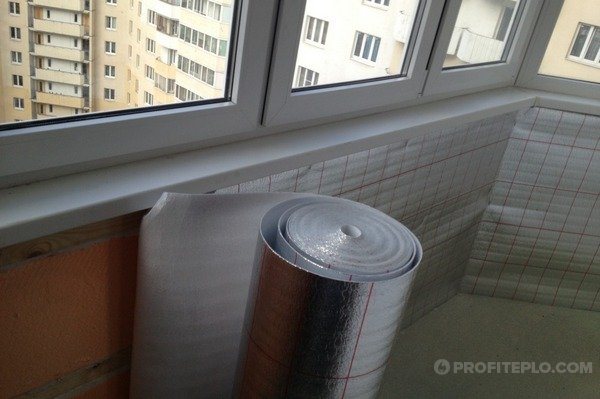

Penofol as insulation
The frame is the basis for fastening wall or ceiling panels, lining, etc. As a flooring on the floor and for filing the ceiling, it is better to use waterproof plywood, which, if desired, can be refined with a finishing material.
